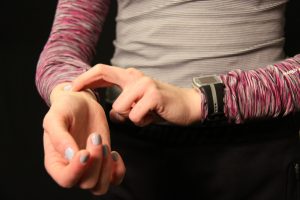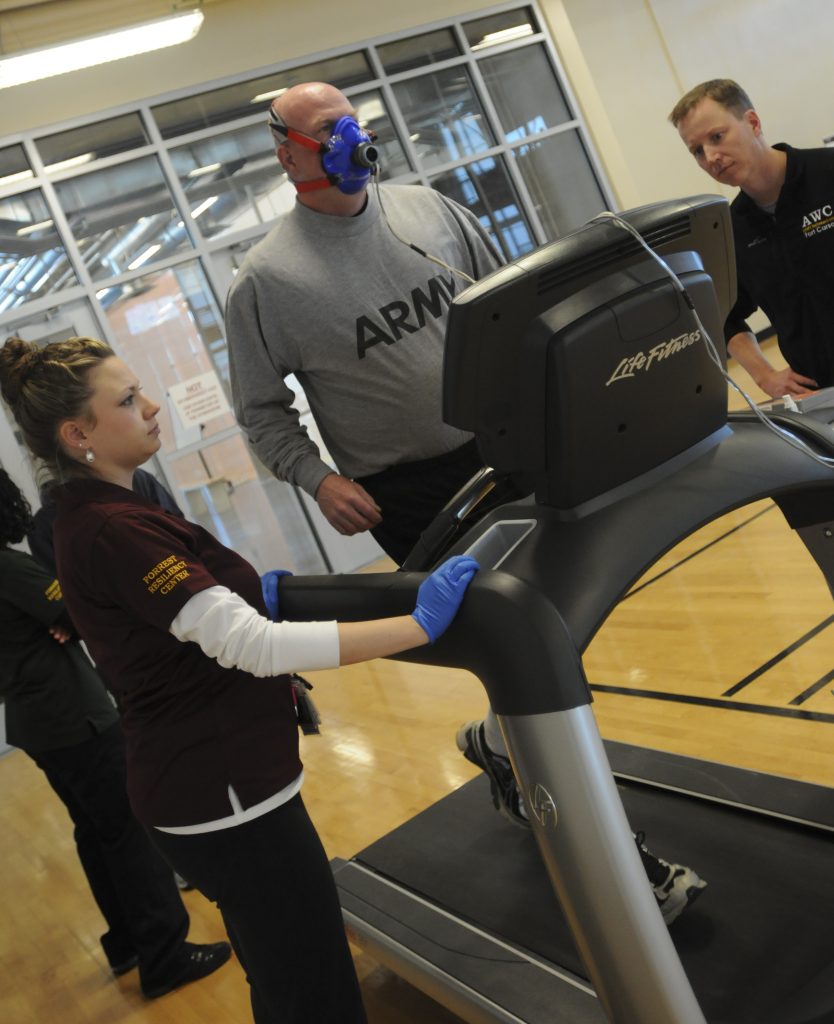10.3 Measuring Intensity and Changes Related to Cardiorespiratory Endurance
Identifying Your Maximum and Target Heart Rates
How will you know if your activity is light, moderate, or vigorous? Measuring your heart rate is a good way to gauge how hard your cardiovascular and respiratory systems are working. This can help you determine whether your physical activity is at a moderate or vigorous intensity. Heart rate can be used to measure exertion by comparing your heart rate to your maximum heart rate. You can estimate your maximum heart rate by subtracting your age from 220. For example, if you are 20 years old, then your maximum heart rate is considered 200 beats per minute—or bpm.
You can identify target heart rate by multiplying your maximum heart rate by your desired intensity level; Exercising at a heart rate that’s:
- 50-70% of the maximum heart rate is considered moderate intensity
- 70-85% of maximum heart rate is considered vigorous intensity
A 20-year-old person’s target heart rate for moderate level activity would be 100-140 bpm—200 x 50-70%. Exercising at 140-170 bpm would be considered vigorous activity—200 x 70-85%.
Keep in mind, cardiorespiratory intensity level can vary within the same activity. For example, you may be cycling at a moderate intensity of 60% of your maximum heart rate, but your heart rate will increase by climbing a hill, increasing the bike’s resistance, or increasing your speed; if your heart rate reaches 70-85% of your max, then you are exercising at a vigorous intensity.
Methods to Measure Your Heart Rate and Intensity Level
Using a heart rate monitor is the most accurate way to measure your actual heart rate. If you don’t have one, you can gauge your heart rate manually. Using the tips of your forefinger and middle finger—not your thumb—on the artery on the thumb side of your wrist or the artery on either side of the neck, count your pulse for 10 seconds. Multiply the number of beats by six to calculate your per-minute heart rate. If you use this method to monitor your heart rate during exercise, be sure to take your pulse within five seconds after interrupting exercise because your heart rate will start to go down once you stop moving.

Another way to gauge how hard you’re working is to use a subjective scale called the Borg Rating of Perceived Exertion Scale:
|
Number |
Level of Exertion |
|---|---|
|
6 |
No exertion at all |
|
7 |
|
|
7.5 |
Extremely light |
|
8 |
|
|
9 |
Very light |
|
10 |
|
|
11 |
Light |
|
12 |
|
|
13 |
Somewhat light |
|
14 |
|
|
15 |
Hard (heavy) |
|
16 |
|
|
17 |
Very hard |
|
18 |
|
|
19 |
Extremely hard |
|
20 |
Maximal exertion |
The scale ranges from 6 to 20, with 6 being no exertion at all and 20 being maximal exertion (Borg, 1970). Rating yourself between 12 and 14 on the scale is generally considered somewhat hard and indicates moderate intensity. A rating of 15-17 would indicate hard or very hard and therefore vigorous intensity. The key is for you to honestly rate how you feel while you’re exercising.
Finally, the simplest way to determine whether you’re working at a moderate or vigorous intensity is to use the talk test. If you can talk—but not sing—while performing the activity, then it’s probably moderately intense. If you can’t say more than a few words without pausing for a breath, then it’s probably vigorous.
Using Cardiorespiratory Fitness to Assess Changes Over Time
Cardiorespiratory fitness is a reflection of the body’s ability to get oxygen through the body during sustained physical activity, so assessing cardiorespiratory fitness is based on oxygen use. In some cases, researchers have used specific exercise protocols to monitor heart rate during exercise or heart rate recovery after exercise to supplement fitness assessments (Shelter et al., 2001). Individuals can assess changes in fitness on their own by monitoring heart beats per minute and breathing during and a few minutes after stopping the activity. Over time, the same intensity exercise should feel less intense and the heart should recover more quickly as oxygen is used more efficiently.
Another way to assess your level of cardiorespiratory fitness for goal-setting purposes is through a VO2 max test. This assessment measures the maximum amount of oxygen a person utilizes through a mouthpiece worn during an intense exercise session. The more oxygen a person is able to use during exercise, the more energy they will have. The VO2 max test is considered one of the most accurate assessments for determining cardiorespiratory fitness. Though it is most commonly used by athletes, many folks could benefit from a VO2 max assessment as a means of assessing changes in fitness over time or establishing a starting point for goal-setting purposes.

Self-Assess Your Understanding
- Describe various ways to assess intensity of cardiorespiratory endurance activities.
- How might one assess changes in cardiorespiratory fitness over time?
maximum heart rate is estimated by subtracting your age from 220; heart rate can be used to measure exertion by comparing your heart rate to your maximum heart rate
measures the maximum amount of oxygen a person utilizes through a mouthpiece worn during an intense exercise session; the more oxygen a person is able to use during exercise, the more energy they will have. Considered one of the most accurate assessments for determining cardiorespiratory fitness.

